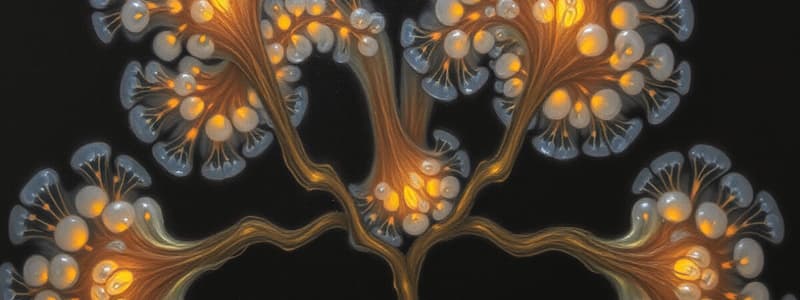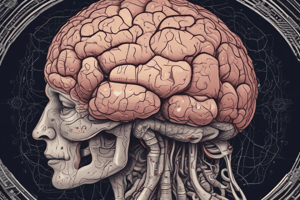Podcast
Questions and Answers
What is the primary characteristic of interstitial edema in obstructive hydrocephalus?
What is the primary characteristic of interstitial edema in obstructive hydrocephalus?
- Increased pressure within the ventricular system
- Fluid accumulation in the nerve cell bodies
- Nerve cell malfunction due to ATP depletion
- Rise in CSF pressure forcing fluid into the ECS (correct)
Which of the following is a cause of cellular swelling in oligodendroglia?
Which of the following is a cause of cellular swelling in oligodendroglia?
- Deficiency in synaptic junction connections
- Accumulation of myelin within the cells
- Nerve impulse propagation failure
- Toxic or metabolic factors affecting the ATP Na-pump (correct)
What percentage of intracranial tumors do neuroglial tumors account for?
What percentage of intracranial tumors do neuroglial tumors account for?
- 50 to 60%
- 40 to 50% (correct)
- 20 to 30%
- 30 to 40%
Which type of cell is primarily responsible for myelination of peripheral nerves?
Which type of cell is primarily responsible for myelination of peripheral nerves?
Which type of tumors arise from astrocytes?
Which type of tumors arise from astrocytes?
What are the scavenger cells of the central nervous system?
What are the scavenger cells of the central nervous system?
Which process is associated with Nissl substance in nerve cell bodies?
Which process is associated with Nissl substance in nerve cell bodies?
What is a defining characteristic of gliomas?
What is a defining characteristic of gliomas?
What is the term for the period during which another action potential cannot be elicited after a nerve impulse has spread?
What is the term for the period during which another action potential cannot be elicited after a nerve impulse has spread?
Which of the following describes the speed of rapid cell transport?
Which of the following describes the speed of rapid cell transport?
In terms of organelle movement, which structure is NOT mentioned as being transported by cell transport mechanisms?
In terms of organelle movement, which structure is NOT mentioned as being transported by cell transport mechanisms?
How do the sizes and frequencies of cell transport impact the process?
How do the sizes and frequencies of cell transport impact the process?
What is the rate of slow cell transport?
What is the rate of slow cell transport?
What is the primary role of centrioles in nerve cells?
What is the primary role of centrioles in nerve cells?
Which of the following correctly describes the resting potential of a nerve cell?
Which of the following correctly describes the resting potential of a nerve cell?
What type of ion predominantly contributes to the steady potential difference of -80mV in nerve cells?
What type of ion predominantly contributes to the steady potential difference of -80mV in nerve cells?
What are lipofuscin granules primarily associated with in nerve cells?
What are lipofuscin granules primarily associated with in nerve cells?
Where are melanin granules primarily found within neurons involved in dopamine synthesis?
Where are melanin granules primarily found within neurons involved in dopamine synthesis?
How is a nerve cell stimulated for action potential generation?
How is a nerve cell stimulated for action potential generation?
Which statement accurately describes the chemical composition of nerve cell membranes?
Which statement accurately describes the chemical composition of nerve cell membranes?
What effect does lysosomal activity have in the context of aging nerve cells?
What effect does lysosomal activity have in the context of aging nerve cells?
What is the primary function of an axon?
What is the primary function of an axon?
What distinguishes amacrine neurons from typical neurons?
What distinguishes amacrine neurons from typical neurons?
What feature of axons allows for the rapid conduction of impulses?
What feature of axons allows for the rapid conduction of impulses?
Which part of the axon is considered the most excitable and the origin of the action potential?
Which part of the axon is considered the most excitable and the origin of the action potential?
What are varicosities in the context of axons?
What are varicosities in the context of axons?
What is the typical length range for axons?
What is the typical length range for axons?
How does axon diameter affect impulse conduction speed?
How does axon diameter affect impulse conduction speed?
What happens to the amplitude of action potentials in different axon sizes?
What happens to the amplitude of action potentials in different axon sizes?
Which of the following accurately describes the nucleus?
Which of the following accurately describes the nucleus?
What is the significance of the Barr Body in females?
What is the significance of the Barr Body in females?
Which of the following best describes microfilaments?
Which of the following best describes microfilaments?
What does the nuclear envelope primarily consist of?
What does the nuclear envelope primarily consist of?
Why are microtubules important in cellular function?
Why are microtubules important in cellular function?
Which of the following statements about neurofilaments is true?
Which of the following statements about neurofilaments is true?
What role do granular and agranular ER play in the cytoplasm?
What role do granular and agranular ER play in the cytoplasm?
What is the diameter of microfilaments?
What is the diameter of microfilaments?
Flashcards are hidden until you start studying
Study Notes
Oligodendroglia and Edema
- Oligodendroglia cells are integral in myelination and contribute to 40-50% of intracranial tumors.
- Interstitial edema refers to fluid accumulation leading to cellular swelling; can occur in obstructive hydrocephalus due to rising cerebrospinal fluid (CSF) pressure.
- Edema results when CSF is forced from the ventricular system into the extracellular space (ECS).
Neoplasms of Neuroglia
- Tumors of neuroglia are called gliomas and can be highly invasive.
- Types of gliomas include astrocytomas, which are the most encountered, and other kinds like ependymomas.
Nissl Substance and Cell Functions
- Nissl substance is associated with protein synthesis and is important for nerve cell function.
- Breakdown in plasma membrane ATP Na-pump leads to toxic and metabolic failures affecting neuronal activity.
Amacrine Neurons
- Amacrine neurons are unique as they lack axons; instead, they typically branch extensively.
- They play a role in processing visual information in the retina through local circuits.
Axonal Structure
- Axons vary in size and perform differently based on their diameter:
- Larger axons conduct impulses rapidly.
- Smaller axons conduct impulses slowly.
- The initial segment after leaving the axon hillock is the most excitable part, leading to action potential (AP) generation.
Cell Components
- Nucleus:
- Central, large, and rounded with a prominent nucleolus for ribosomal RNA (rRNA) synthesis.
- Contains Barr Body, a compacted x-chromosome in females.
- Cytoplasm contains rough and smooth endoplasmic reticulum and substances like lipofuscin, a byproduct that accumulates with age.
Cytoskeleton Components
- Microfilaments (3-5 nm) formed by actin assist in cell shape and movements.
- Microtubules (25 nm) serve as tracks for organelle movement and are key components of axon transport.
Membrane Potential
- Potassium (K+) permeability is greater than sodium (Na+) permeability across the cell membrane, resulting in a resting potential of -80mV.
- The inside of the cell membrane is negative relative to the outside, known as the resting potential.
Cell Transport Mechanisms
- Function of cell transport includes the movement of organelles and materials crucial for neuron maintenance and function.
- There are two types:
- Rapid Cell Transport (100-400 mm/day).
- Slow Cell Transport (0.1-3 mm/day).
Synapses
- Synapses are the junctions where two neurons are in close proximity, allowing for signal transmission.
Studying That Suits You
Use AI to generate personalized quizzes and flashcards to suit your learning preferences.




